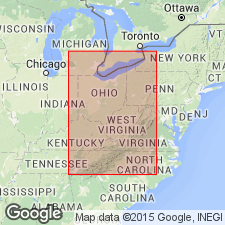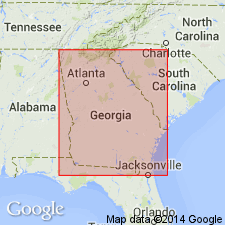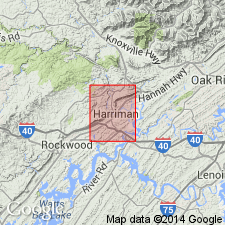
- Usage in publication:
-
- Sequatchie formation*
- Modifications:
-
- Original reference
- AAPG geologic province:
-
- Appalachian basin
Summary:
Pg. 614, 646, 647, 648, 649, 651, 665, and plate. Sequatchie formation. Local designation for all deposits of Richmond age [Late Ordovician] in southern Appalachian Valley. Consists of red shales and argillaceous limestones, heavier-bedded in upper part. Unconformably overlies Fairview formation and unconformably underlies Clinch sandstone. Eastern border of the Sequatchie is usually confined to Clinton trough. Is = to Arnheim, Waynesville, Liberty, Whitewater, and Elkhorn stages of Indiana and Ohio. The Juniata attains its greatest development in central Pennsylvania and thins southwardly. Nearing the border of Tennessee it seems to pass into the more calcareous Sequatchie formation, in which facies the deposits of this age extend into northeastern Alabama.
[GNC remark (ca. 1938, US geologic names lexicon, USGS Bull. 896, p. 1956-1957): The present accepted definition of Sequatchie formation limits it to marine limy beds west of Powell's Valley, in eastern Tennessee, southwestern Virginia, and northern Alabama, which are the time equivalents of Juniata sandstone of Clinch Mountain and northward. In southwestern Virginia and northeastern Tennessee it is overlain by Clinch sandstone and underlain by Reedsville shale.]
Source: US geologic names lexicon (USGS Bull. 896, p. 1956-1957).

- Usage in publication:
-
- Sequatchie Formation
- Modifications:
-
- Overview
- AAPG geologic province:
-
- Appalachian basin
Summary:
Sequatchie Formation is subdivided at Ringgold Gap, Catoosa Co., GA, into ascending 'Ringgold' [informal], Shellmound, and Mannie Members (after Rindsberg and Chowns, 1986). At Dug Gap, Rocky Face Mountain, Whitfield Co., GA, unit is divided into 'Ringgold' and Dug Gap Members, following the nomenclature of Zeigler (1989: Emory Univ. MS thesis).
Source: GNU records (USGS DDS-6; Reston GNULEX).

- Usage in publication:
-
- Sequatchie Formation
- Modifications:
-
- Overview
- AAPG geologic province:
-
- Appalachian basin
Summary:
Sequatchie Formation mapped in Roane Co., eastern TN. Consists of mottled red and green, medium-gray and brownish-gray, very silty and argillaceous, medium-bedded limestone. Contains interbeds of olive-gray to dark-red, calcareous shale. 100 ft thick in study area. Overlies Middle Ordovician Chickamauga Limestone and underlies Lower and Middle Silurian Rockwood Formation. Age is Late Ordovician.
Source: GNU records (USGS DDS-6; Reston GNULEX).
For more information, please contact Nancy Stamm, Geologic Names Committee Secretary.
Asterisk (*) indicates published by U.S. Geological Survey authors.
"No current usage" (†) implies that a name has been abandoned or has fallen into disuse. Former usage and, if known, replacement name given in parentheses ( ).
Slash (/) indicates name conflicts with nomenclatural guidelines (CSN, 1933; ACSN, 1961, 1970; NACSN, 1983, 2005, 2021). May be explained within brackets ([ ]).

